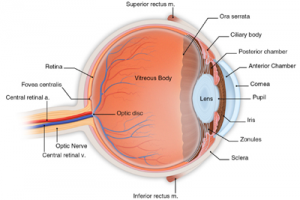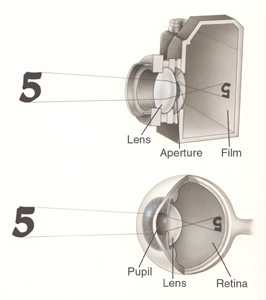Eye Anatomy
 At our offices in Brooklyn, eye exams are taken very seriously. We understand that the eye is a complicated organ with many parts. In order to see well, each part must be healthy. As light enters the eye, it must first pass through the lubricating tear film and the cornea. The cornea is the clear window that covers the front of the eye and helps focus the incoming light rays.
At our offices in Brooklyn, eye exams are taken very seriously. We understand that the eye is a complicated organ with many parts. In order to see well, each part must be healthy. As light enters the eye, it must first pass through the lubricating tear film and the cornea. The cornea is the clear window that covers the front of the eye and helps focus the incoming light rays.
Light then passes through the anterior chamber of the eye and through the aqueous humor. The clear fluid circulates throughout the front of the eye and helps to maintain a healthy eye pressure. The iris is the colored part of the eye. In a dark setting, like those used by our office in Brooklyn for eye exam appointments, the iris dilates making the pupil larger and allowing more light into the eye. In light conditions, the iris constricts and the pupil becomes smaller.
 Light then travels through the lens of the eye. Much like the lens in a camera, the human lens helps focus light onto the retina. In younger patients, the lens can change its shape and thus help the eye focus on distant objects or near objects.
Light then travels through the lens of the eye. Much like the lens in a camera, the human lens helps focus light onto the retina. In younger patients, the lens can change its shape and thus help the eye focus on distant objects or near objects.
Light then travels through the vitreous humor or gel and finally focuses on the retina. The retina is the thin light sensitive tissue in the back of the eye that is similar to film in a camera. In order to see well, light must focus on the retina. In the center of the retina is the macula, which is responsible for our near vision. In the center of the macula is the fovea, responsible for our sharpest vision.
The choroid, the layer behind the retina, contains blood vessels and supplies oxygen and nutrients to the retina. The white part of the eye is called the sclera. It is composed of dense fibrotic tissue, which protects the inner parts of the eye. In order to see, light then passes from the retina through the optic nerve to the brain.
To learn more about your vision and to talk with a specialist, make an appointment for a comprehensive eye exam at Brooklyn’s Brighton Eye.

